
Sunbirds and spiderhunters make up the family Nectariniidae of passerine birds. They are small, slender passerines from the Old World, usually with downward-curved bills. Many are brightly coloured, often with iridescent feathers, particularly in the males. Many species also have especially long tail feathers. Their range extends through most of Africa to the Middle East, South Asia, South-east Asia and southern China, to Indonesia, New Guinea and northern Australia. Species diversity is highest in equatorial regions.

The black-chinned hummingbird is a small hummingbird occupying a broad range of habitats. It is migratory, spending winter as far south as Mexico.

Heliconia, derived from the Greek word Ἑλικώνιος, is a genus of flowering plants in the monotypic family Heliconiaceae. Most of the ca 194 known species are native to the tropical Americas, but a few are indigenous to certain islands of the western Pacific and Maluku. Many species of Heliconia are found in the tropical forests of these regions. Most species are listed as either vulnerable or data deficient by the IUCN Red List of threatened species. Several species are widely cultivated as ornamentals, and a few are naturalized in Florida, Gambia, and Thailand. Common names for the genus include lobster-claws, toucan beak, wild plantain, or false bird-of-paradise. The last term refers to their close similarity to the bird-of-paradise flowers (Strelitzia). Collectively, these plants are also simply referred to as "heliconias".

The calliope hummingbird is the smallest bird native to the United States and Canada. It has a western breeding range mainly from California to British Columbia, and migrates to the Southwestern United States, Mexico, and Central America for its wintering grounds. It was previously considered the only member of the genus Stellula, but recent evidence suggests placement in the genus Selasphorus. This bird was named after the Greek muse Calliope. The former genus name means "little star".

The giant hummingbird is the only member of the genus Patagona and the largest member of the hummingbird family, weighing 18–24 g (0.63–0.85 oz) and having a wingspan of approximately 21.5 cm (8.5 in) and length of 23 cm (9.1 in). This is approximately the same length as a European starling or a northern cardinal, though the giant hummingbird is considerably lighter because it has a slender build and long bill, making the body a smaller proportion of the total length. This weight is almost twice that of the next heaviest hummingbird species and ten times that of the smallest, the bee hummingbird.
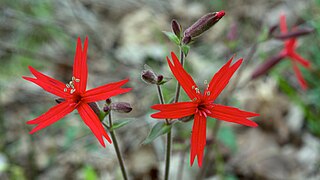
Silene virginica, the fire pink, is a wildflower in the pink family, Caryophyllaceae. It is known for its distinct brilliant red flowers. Each flower is approximately five centimeters in diameter and composed of five notched, brilliant red petals which extend into a long tube. It is a small, short-lived perennial, with lance shaped leaves. Its stems, and the bases of the flowers, are covered in short sticky hairs. Fire pink begins blooming in late spring and continuing throughout the summer. It is sometimes grown in wildflower, shade, and rock gardens.

The sword-billed hummingbird is a neotropical species of hummingbird from the Andean regions of South America. It is the sole member of the genus Ensifera and is characterized by its unusually long bill; it is the only bird to have a beak longer than the rest of its body. E. ensifera uses its bill to drink nectar from flowers with long corollas and has coevolved with the species Passiflora mixta. While most hummingbirds preen using their bills, E. ensifera must use its feet to scratch and preen due to its bill being so long. This uncommon bird is also one of the largest hummingbird species.

Impatiens capensis, the orange jewelweed, common jewelweed, spotted jewelweed, or orange balsam, is an annual plant which is native to eastern North America. It is common in bottomland soils, ditches, and along creeks, often growing side-by-side with its less common relative, yellow jewelweed.

The broad-billed hummingbird is a small-sized hummingbird that resides in Mexico and the southwestern United States. The bird displays sexual dimorphism, and the juveniles resemble the female adult more than the male adult. The broad-billed hummingbird is a bright coloured bird with a broad and bright red bill. The bird is also known for its other common names – the Colibrí Pico Ancho in Spanish and Colibri circé in French. It is a diurnal bird.
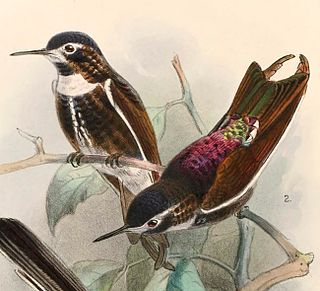
The purple-backed sunbeam is a bird species in the family Trochilidae. It is found only in Peru.

The grey-bellied comet is a species of hummingbird in the family Trochilidae. It is found only in a few small areas of Peru. Its natural habitats are subtropical or tropical high-altitude shrubland and rural gardens. It is threatened by habitat loss.
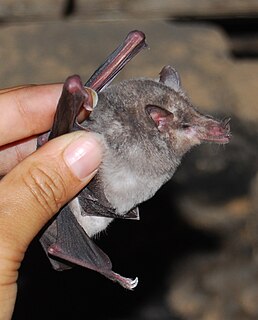
The long-snouted bat is a species of bat in the family Phyllostomidae. It is monotypic within the genus Platalina. It is endemic to northern Peru and northern Chile. It feeds almost exclusively on the nectar and fruit of the columnar cactus. The species is rare, but has a wide distribution with at least 25 populations, and is listed as near-threatened due to habitat loss causing the removal of their primary food source.

Rhaphithamnus venustus, known locally as Juan Bueno, is a species of plant in the family Verbenaceae. It is endemic to the Juan Fernández Islands, an archipelago west of Chile. It is threatened by habitat loss.
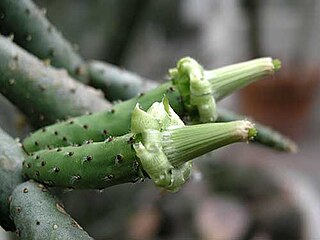
Tacinga funalis is a species of plant in the family Cactaceae. It is endemic to Brazil. Its natural habitats are subtropical or tropical dry forests and subtropical or tropical dry shrubland. It is threatened by habitat loss.
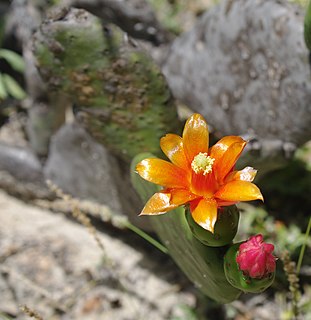
Tacinga inamoena is a species of plant in the family Cactaceae. It is endemic to Brazil. Its natural habitats are subtropical or tropical dry forests, subtropical or tropical dry shrubland, and rocky areas. It is threatened by habitat loss.

Tacinga palmadora is a species of plant in the family Cactaceae. It is endemic to Brazil. Its natural habitats are subtropical or tropical dry forests and subtropical or tropical dry shrubland. It is threatened by habitat loss.
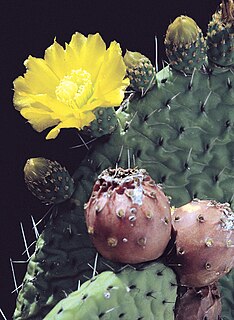
Tacinga saxatilis is a species of plant in the family Cactaceae. It is endemic to Brazil. Its natural habitats are subtropical or tropical dry forests, temperate shrubland, and rocky areas. It is threatened by habitat loss.

Tacinga werneri is a species of plant in the family Cactaceae. It is endemic to Brazil. Its natural habitats are subtropical or tropical dry forests and hot deserts. It is threatened by habitat loss.

Silene regia is a species of flowering plant in the family Caryophyllaceae known by the common name royal catchfly. It is native to the central United States. A perennial herb, it grows from a fleshy taproot and has several erect stems growing up to 1.6 meters tall. The leaves are lance-shaped to oval and up to 12 centimeters long, becoming smaller farther up the stem. The inflorescence is an array of many flowers at the top of the stem. The elongate tubular calyx of sepals is up to 2.5 centimeters long and has 10 longitudinal veins. The lobes of the bright red corolla are 1 to 2 centimeters long.

Petunia exserta is a rare member of the genus Petunia, endemic to the Serras de Sudeste in southern Brazil. First described in 1987, only fourteen plants were found in the wild during an expedition in 2007. In the wild, the plant is found growing only in shaded cracks on sandstone towers. It is the only Petunia species that is naturally pollinated by hummingbirds, and the only red flowered Petunia species.




















